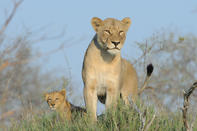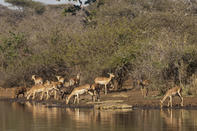Cattle or Game
In 1902, the Sabi Game Reserve was proclaimed which had an area about twice the size of the present day Kruger National Park. The new game reserve was a mixed-use reserve, with areas being used for grazing and farmers being allowed to shoot any game in defence of their livestock.

In 1922, MalaMala was a farm, which was acquired by the Transvaal Consolidated Land and Exploration Company (TCL for short). It was predominately a cattle farm with over 800 head of cattle. However, this was a disease and lion infested part of the country, with the TCL managers spending a lot of time and energy shooting the lions that came to purloin the cattle.
Over a period of six years, the TCL managers had shot over 500 lions, in an attempt to safeguard their cattle. In 1926, the National Parks Act was passed, which reduced the Sabi Game Reserve by almost half and resulted in the present day Kruger National Park, with stricter laws re hunting and conservation policies.
The land to the west of Kruger was now offered for private ownership, albeit not favourable for farming it was seen to be good as a wildlife haven. Individuals purchased the land and used it for private game viewing, hunting and relaxation. William Alfred Campbell (known affectionately as Wac) purchased a farm called Eyrefield for the grand sum of 2150 Pounds. Then in 1929, he bought MalaMala for 3656 Pounds. Loring Rattray bought a farm next to MalaMala called Exeter in 1937 and another farm called Wallington in 1939.
The Start of MalaMala

Wac built the first MalaMala Camp in the area close to where the Mlowathi River flows into the Sand River, but when the rains came it made it difficult to cross. So in 1930, the camp was moved to the west bank of the river, which is where it is still situated today. The camp was used only in the winter months and catered handsomely for hunting, with many a guest belonging to royalty.
Some of these early royal guests included Alexander Cambridge, 1st Earl of Athlone, the former Governor-General of the Union of South Africa and his wife Her Royal Highness Princess Alice. Lady Campbell arrived at MalaMala for the first time in 1935 and immediately set about to transform the camp into something more feminine and planted bougainvillaea around the camp.
This signature bloom of shocking pink is still growing along the pathways of the camp today. Campbell spent more than 30 years recording the comings and goings of the wildlife around MalaMala and his observations of the animals behaviours. In 1960 he made his final report, where he noted that the warthog numbers were increasing but that the sable antelope was on the decline.
His final report also mentioned that during that season 130 guests had visited MalaMala and that over half of the guests had been women and children, which was quite novel then. He never returned to MalaMala. In 1962, Wac Campbell died and his son Urban inherited the farm, which he sold in 1964 to a company called MalaMala Ranch (Pty) Ltd. whose shares belonged to Loring Rattray. With the other two farms that the Rattray family owned, they have developed MalaMala to its present status as a major game viewing resort with an international reputation.